More info
Datasheet
| Minimum Tank Size | 53 litres / 14.00 US gallons |
| Maximum Size | 9.5cm / 3.74inches |
| Temperature | 25°C / 77.00°F - 28°C / 82.40°F |
| Hardness | 5-20ºdH |
| pH | 6.0-8.0 |
General Description
The Whiptail Catfish, scientifically known as Rineloricaria Lanceolata, is a peaceful species popularly sold under the name 'whiptail catfish.' Originating from Peru and Brazil, these catfish are relatively inactive but can be interactive when settled in a suitable environment. With a maximum size of 9.5cm, they are ideal for beginners in the realm of Loricariids and catfish breeding.
Aquarium Setup
For optimal care, a tank size of at least 53 litres is recommended. The Whiptail Catfish thrives in setups that mimic its natural habitat, such as sandy substrates covered in leaf litter. Tank decorations like twisted branches, rounded stones, rock or wood caves, and lengths of PVC piping provide hiding spots and potential spawning sites. They can also be housed in well-planted tanks but prefer subdued lighting conditions.
Behaviour
Known for their peaceful nature, Whiptail Catfish can coexist with various species, including small characins, Apistogramma, and Corydoras, as well as other quiet Loricariids. They are best kept in a community of tranquil fish and can become shy and out-competed for food in the presence of vigorous or aggressive tankmates. These catfish are not territorial unless spawning and tend to thrive when housed in small groups.
Feeding and Diet
In their natural habitat, Whiptail Catfish feed on aufwuchs and small aquatic crustaceans. In an aquarium setting, they are omnivorous and accept a diet consisting of sinking dried foods, vegetable matter like blanched spinach and kale, and live or frozen fare such as bloodworms or daphnia.
Reproduction & Dimorphism
Breeding Whiptail Catfish can be relatively easy with proper conditions and nutrition. Males develop odontotes on their head and pectoral spines, which distinguish them from females. Spawning caves made of PVC piping in slightly acidic and soft water are ideal for breeding. The male guards and tends to the eggs diligently until they hatch, after which the fry require nutrient-rich greenstuffs and tiny live foods like microworms and brine shrimp nauplii.
Habitat and Distribution
Typically found in leaf litter over sandy substrates, Whiptail Catfish inhabit both clear and whitewater habitats in their native regions of Peru and Brazil. Whitewater habitats are characterized by high sediment content in the water, as opposed to rapids.
Please note that the water conditions are not included in this text as the specific details are not provided.

